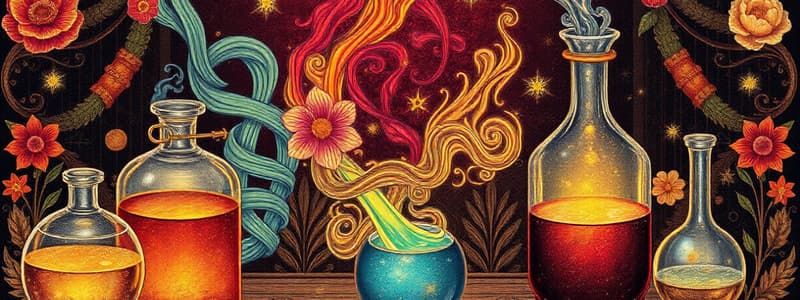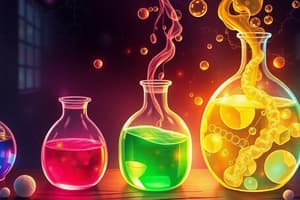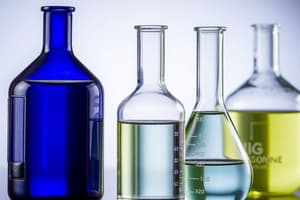Podcast
Questions and Answers
Which process is NOT an example of a chemical reaction?
Which process is NOT an example of a chemical reaction?
- Rising of bread dough
- Milk turning sour
- Explosion of fireworks
- Boiling of water (correct)
What compound is formed when an element is burned in air?
What compound is formed when an element is burned in air?
- Copper sulphate
- Carbon dioxide (correct)
- Alumina
- Sodium chloride
Respiration, combustion, and rusting are similar because they all involve which process?
Respiration, combustion, and rusting are similar because they all involve which process?
- Oxidation (correct)
- Breathing
- Burning
- Pollution
Nitric acid can be used to manufacture which of the following?
Nitric acid can be used to manufacture which of the following?
Harry investigates liquid Z. It turns phenolphthalein indicator pink and red litmus paper blue. What could liquid Z be?
Harry investigates liquid Z. It turns phenolphthalein indicator pink and red litmus paper blue. What could liquid Z be?
Given the color changes of indicators P, Q, and R, what color would they be in pure water (pH 7)?
Indicator P: red below pH 4, yellow above pH 4
Indicator Q: blue below pH 5, red above pH 5
Indicator R: colorless below pH 9, red above pH 9
Given the color changes of indicators P, Q, and R, what color would they be in pure water (pH 7)?
Indicator P: red below pH 4, yellow above pH 4 Indicator Q: blue below pH 5, red above pH 5 Indicator R: colorless below pH 9, red above pH 9
An unknown red solid is heated strongly, producing a silvery liquid and a gas. What can be deduced about the red solid?
An unknown red solid is heated strongly, producing a silvery liquid and a gas. What can be deduced about the red solid?
Mr. Lee is stung by a wasp. The venom is alkaline. What can he apply to neutralize the venom?
Mr. Lee is stung by a wasp. The venom is alkaline. What can he apply to neutralize the venom?
Suzy uses a dye made from plants to test substances. The results are: Rainwater (Red), Shampoo (Yellow), Sugar solution (No change), Toothpaste (Yellow), Orange juice (Red). What can Suzy infer from these results?
Suzy uses a dye made from plants to test substances. The results are: Rainwater (Red), Shampoo (Yellow), Sugar solution (No change), Toothpaste (Yellow), Orange juice (Red). What can Suzy infer from these results?
Which of the following is an example of combustion?
Which of the following is an example of combustion?
Consider four solutions with varying pH: W (Sulfuric acid), X (Lime juice), Y (ammonia), and Z (Milk of magnesia). Based on their likely pH values, what is the arrangement from most acidic to most alkaline?
Consider four solutions with varying pH: W (Sulfuric acid), X (Lime juice), Y (ammonia), and Z (Milk of magnesia). Based on their likely pH values, what is the arrangement from most acidic to most alkaline?
Acid rain is causing the death of fish in a lake. What substance can be added to the lake to reduce the effects of acid rain?
Acid rain is causing the death of fish in a lake. What substance can be added to the lake to reduce the effects of acid rain?
Some purple crystals are heated in a boiling tube. The crystals turn black, and a colorless, odorless gas is released. What type of reaction has taken place?
Some purple crystals are heated in a boiling tube. The crystals turn black, and a colorless, odorless gas is released. What type of reaction has taken place?
Which of the following correctly describes the color of Thymol blue, Congo red and phenolphthalein in pure water?
Which of the following correctly describes the color of Thymol blue, Congo red and phenolphthalein in pure water?
Which substance reacts with dilute hydrochloric acid to produce water and a salt ONLY?
Which substance reacts with dilute hydrochloric acid to produce water and a salt ONLY?
Which of the following is most likely to result in neutral pH, when mixed?
Which of the following is most likely to result in neutral pH, when mixed?
Based on the graph, what volume of alkaline solution must be added to achieve a neutral mixture?
Based on the graph, what volume of alkaline solution must be added to achieve a neutral mixture?
Which process does NOT describe a chemical change?
Which process does NOT describe a chemical change?
Which statement(s) is/are correct about gold-plating?
Which statement(s) is/are correct about gold-plating?
Zinc reacts with excess hydrochloric acid. Why does the graph level off at X?
Zinc reacts with excess hydrochloric acid. Why does the graph level off at X?
Which one of the following is NOT a chemical change?
Which one of the following is NOT a chemical change?
Based on the word equation, what could substance Y be?
Sulphuric acid + Y → a salt + water + carbon dioxide
Based on the word equation, what could substance Y be?
Sulphuric acid + Y → a salt + water + carbon dioxide
Which of the following gases is NOT released during the burning of fuels?
Which of the following gases is NOT released during the burning of fuels?
When solid mercury oxide is heated, it forms mercury and oxygen. What can be deduced from this information?
mercury oxide → mercury + oxygen
When solid mercury oxide is heated, it forms mercury and oxygen. What can be deduced from this information?
mercury oxide → mercury + oxygen
Which of the following processes are initiated by the presence of light?
Which of the following processes are initiated by the presence of light?
Which indicator is NOT suitable for testing sugar solution with nitric acid?
Which indicator is NOT suitable for testing sugar solution with nitric acid?
Which of the following statements is NOT correct?
Which of the following statements is NOT correct?
When sulfuric acid is added to calcium carbonate, what is produced?
When sulfuric acid is added to calcium carbonate, what is produced?
Which statement does NOT describe a property of an acid in solution?
Which statement does NOT describe a property of an acid in solution?
Which of these are properties of alkalis?
Which of these are properties of alkalis?
Which of the following solutions will cause the three indicators to appear yellow?
Methyl orange: red at pH < 3.1, yellow at pH > 4.4
Bromothymol blue: yellow at pH < 6.0, blue at pH > 7.6
Phenol red: yellow at pH < 6.8, red at pH > 8.4
Which of the following solutions will cause the three indicators to appear yellow?
Methyl orange: red at pH < 3.1, yellow at pH > 4.4 Bromothymol blue: yellow at pH < 6.0, blue at pH > 7.6 Phenol red: yellow at pH < 6.8, red at pH > 8.4
The gaseous product of photosynthesis can be identified using:
The gaseous product of photosynthesis can be identified using:
When ethylene ($C_2H_4$), burns in oxygen, carbon dioxide and water are produced. The type of chemical reaction that has taken place may be classified as:
When ethylene ($C_2H_4$), burns in oxygen, carbon dioxide and water are produced. The type of chemical reaction that has taken place may be classified as:
Which one of the following solutions will have the lowest pH value?
Which one of the following solutions will have the lowest pH value?
Flashcards
What is a chemical change?
What is a chemical change?
A change involving the rearrangement of atoms to form new substances.
What are Chemical Gardens?
What are Chemical Gardens?
Rocks made by the reaction of metal salts with sodium silicate, forming plant-like precipitates.
Why understand chemical changes?
Why understand chemical changes?
The capacity of changes to be used to improve life quality, like controlling reactions.
What is combustion?
What is combustion?
Signup and view all the flashcards
What is an indicator?
What is an indicator?
Signup and view all the flashcards
What is neutralization?
What is neutralization?
Signup and view all the flashcards
What is Rusting?
What is Rusting?
Signup and view all the flashcards
What is Sublimation?
What is Sublimation?
Signup and view all the flashcards
What is Thermal Decomposition?
What is Thermal Decomposition?
Signup and view all the flashcards
Study Notes
- Chemical changes can be dangerous or magical.
- Magic Rocks or Chemical Gardens are formed when metal salts react with sodium silicate to create colored precipitates.
- The precipitates in chemical gardens form plant-like structures, hence the name.
- The chapter focuses on different types of chemical changes
- Understanding chemical changes enables control and improvements in life quality.
Section A - Chemical Changes Questions
- Question 1: Identifying a non-chemical reaction among options like exploding fireworks, milk souring, boiling water, or bread dough rising.
- Question 2: Determining the resulting compound when an element is burned in air.
- Question 3: Recognizing the commonality between respiration, combustion, and rusting.
- Question 4: Identifying the product that nitric acid can be used to create.
Questions on Properties and Indicators
- Question 5: Identifying a liquid based on its reaction with phenolphthalein and litmus paper.
- Question 6: Inferring indicator colors (P, Q, R) when added to pure water, based on pH color changes.
- Question 7: Deducing the nature of a red solid when heated strongly and produces a silvery liquid and a gas.
- Question 8: Determining a suitable substance to neutralize wasp venom given its alkaline nature.
- Question 9: Interpreting dye test results from plants on different substances to infer dye properties.
- Question 10: Recognizing an example of combustion among given reactions.
- Question 11: Identifying solutions W, X, Y, and Z based on their pH levels (1, 7, etc.).
- Question 12: Determining an additive to reduce acid rain's impact in a lake.
- Question 13: Identifying the reaction type when heating purple crystals leads to blackening and gas release.
- Question 14: Describing indicator colors (thymol blue, congo red, phenolphthalein) in pure water.
- Question 15: Identifying substances reacting with dilute hydrochloric acid to yield water and salt.
- Question 16: Determining which solutions, based on pH, will likely mix to produce a neutral pH.
pH and Chemical Process Questions
- Question 17: Determining the volume of alkaline solution needed to neutralize an acid based on a pH change graph.
- Question 18: Identifying the option that does not describe a chemical change.
- Question 19: Evaluating statements about gold-plating (electrolyte use, layer on plates, chemical change due to electricity).
- Question 20: Analyzing a graph showing hydrogen gas volume over time when zinc reacts with excess dilute hydrochloric acid.
- Question 21: Identifying an option that is not a chemical change.
- Question 22: Identifying substance Y in a chemical reaction: Sulfuric acid + Y → salt + water + carbon dioxide.
- Question 23: Identifying which gas is not released during the burning of fuels.
- Question 24: Deducing information from the heating of solid mercury oxide into mercury and oxygen.
- Question 25: Recognizing processes initiated by light presence.
Colour Change Questions
- Question 26: Determining which indicator is unsuitable for identifying a sugar solution from nitric acid, based on color changes in acidic, neutral, and alkaline solutions.
- Question 27: Identifying the NOT correct statement about a magnesium block added to dilute acid.
- Question 28: Determining the result when sulfuric acid is added to calcium carbonate regarding gas production.
- Question 29: Finding the statement that doesn't describe an acid property in solution.
- Question 30: Identifying the property of alkalis.
- Question 31: Finding the solution for which the three indicators will appear yellow using a table of three indicators showing pH values.
- Question 32: Determining what to use to identify the gaseous product of photosynthesis.
Reactions and Properties Questions
- Question 33: Identifying the type of chemical reaction when ethylene burns in oxygen.
- Question 34: Determines which solutions would have the lowest pH values.
- Question 35: Determining the solution formed after sulfuric acid reacts completely with iron(II) carbonate.
- Question 36:Determining how to know that the acid has been used up completely when sulfuric acid reacts completely with iron(II) carbonate.
- Question 37: Determining which substances most probably went through a chemical change upon heating out of four.
- Question 38: Determining which of the following indicators can be used to find out the strength of an acid or alkali.
- Question 39: Determining which acid is found in our stomach which can help in digesting food.
- Question 40: Determining if accidental swallowing of alkali will be treated by swallowing of an acid.
Section B - Chemical Changes and Electrolysis
- Question 1: Discusses the effect of electricity on water, breaking it into substances X and Y.
- Part (a): Asks for the name of the process taking place.
- Part (b): Requires the identification of elements X and Y.
- Part (c): Asks whether water is a compound or a mixture based on the experiment.
- Question 2: Deals with dilute sulfuric acid reacting with green copper(II) carbonate, yielding a blue solution and gas.
- Part (i): Asks what should be expected.
- Part (ii): Requires a description of how the gas may be tested.
Acid Compounds/Everyday Life Groups
- Question 3: Word equation on the reaction of sulphuric acid + copper (II) carbonate.
- Provide the definition of neutralisation and its application in everyday life
- Question 4: asks students to look at 2 groups of objects.
- Name differences between the 2 groups.
- Question 5: Removing labels of 2 bottles (zinc / copper) find if the appearance will assist.
Physical and Chemical Properties/ Heating
- Question 4: Matter interaction that brings physical and chemical change.
- Asking the differences between physical and chemical change.
- Physical change interaction with heat.
- Chemical change interactions with light.
- Question 5: Formulae on burning magnesium ribbon in air, heating copper (II) carbonate, and heating iron filings with sulphur.
Rusting Process, Factors and Equations
- Question 6: Four students investigating the factors that cause rusting of the nail.
- Asking whether rusting is a chemical or physical change.
- Name the process of rusting including the equations.
- Question 7: table on some information about heating copper and 2 compounds
- Asking which substance remained unchanged after heating.
- Write the reaction name for copper heating.
- Discuss and write the decreasing mass equation for copper carbonate after heating.
Acids and Alkalis
- Question 8: Tom, testing acid and alkalis with plant extracts.
- Asking to choose a plant extract not used as an indicator.
- State what the colour changes will be when the geranium extract and sodium hydroxide.
- State what the colour changes will be when the red cabbage extract and vinegar.
- Question 9: Student heating some substances to determine phase.
- State an observation (with support) that shows physical change.
- Explain the gas which magnesium ribbon reacted with and the name of the products forming.
- Question 10: Main ingredient in eggs tells is a calcium carbonate
- Write calcium carbonate's formula.
- Limestones formula equation.
Section C - Chemical Equations and Formulas
- Question 1:
- The figure below shows some chemical reactions with Substance X and asks to identify the unknown substance or gas.
- Identify substances X, Y, and Z
- Name the reaction between substance X and potassium hydroxide
- What are the colour changes, if any, when a Universal Indicator is added to Magnesium Chloride?
- Conduct a chemical test for carbon dioxide gas.
- If substance Z is soluble in water and easily decomposed by heat, how would a dry sample of substance Z be obtained.
- If substance Z is soluble in water and stable to heat, how would a dry sample of substance Z be obtained.
Acids and Alkalines
- Question 2:
- Discuss states of sodium nitrate (a salt) reacting an acid with an alkali
- State the name of the reaction that occurs between the acid and alkali.
- State an acid and an acid that is a form of sodium nitrate, with the formula.
Chemical Equations with Magnesium and Zinc
- Question 3: -Laboratory officer mixing beakers with powdered magnesium or zinc carbonate, describe the best equations or method to use to confirm.
Studying That Suits You
Use AI to generate personalized quizzes and flashcards to suit your learning preferences.





